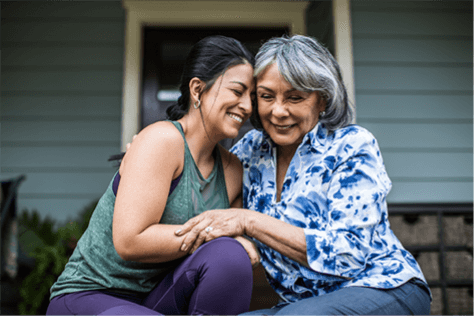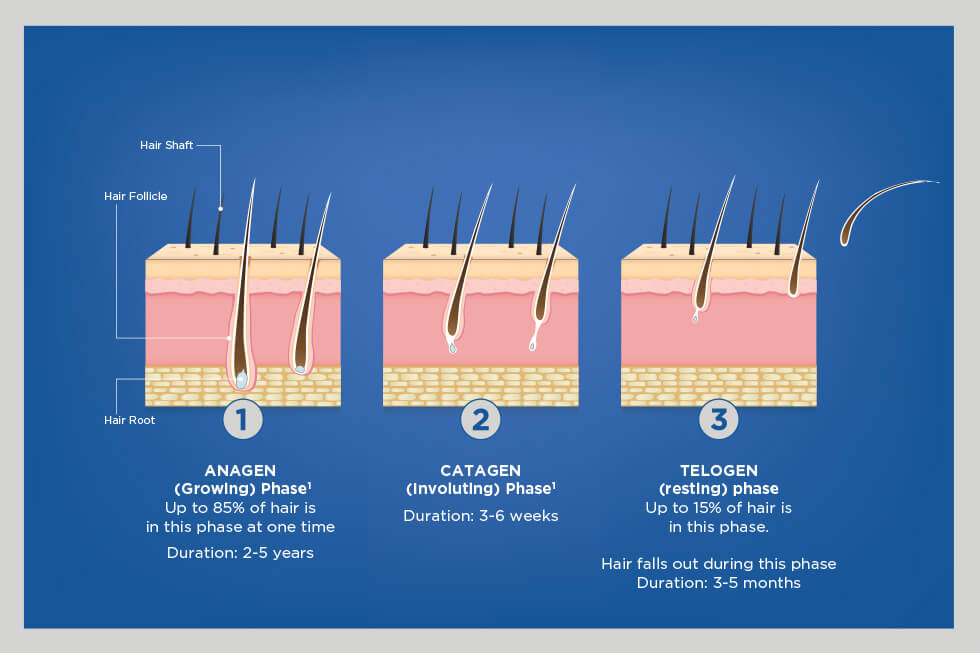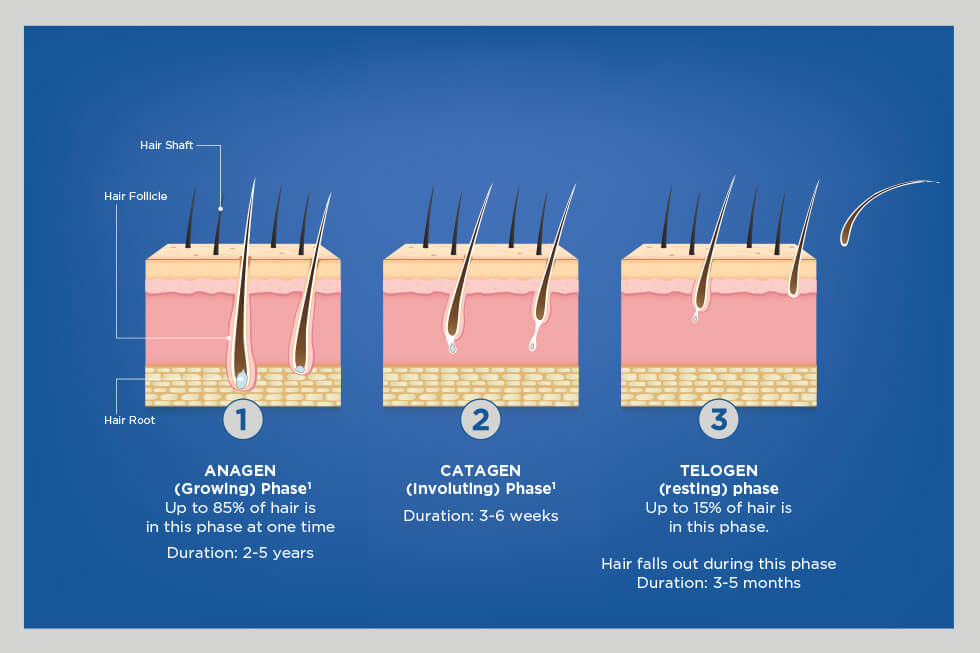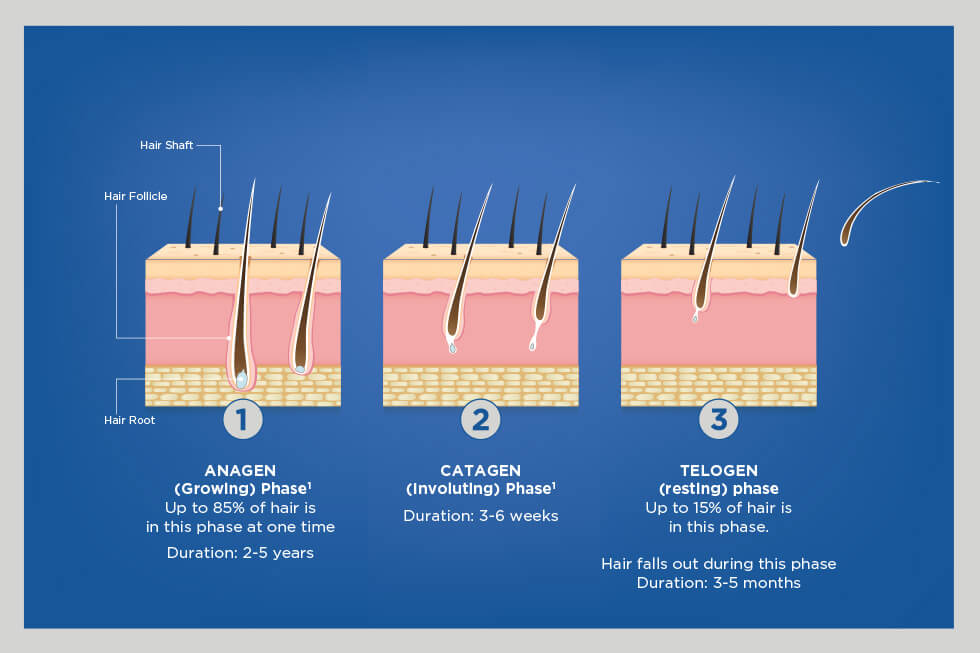What can cause hair loss in women?
There are many reasons why you may be experiencing hair loss. Below are a few of the reasons:

Hereditary/Genetic Hair Loss in Women
Female pattern hair loss, also known as androgenetic alopecia (AGA) is an inherited condition, which reduces the time that the hair spends actively growing.17 AGA causes the hair follicles to become smaller and slowly, thinner, lighter hair replaces your usual hair. In female pattern hair loss, the most prominent hair loss happens on the top of the head and along the parting.17,31
Stages of Hair Growth Cycle & How Hair Loss Happens in Women
The hair growth cycle has three phases.13 Once you understand the natural process occurring in your follicles during these three phases you can start taking steps to help your hair regrow.

PHASE 1: GROWTH (OR ANAGEN) PHASE
For every hair on your head, the cycle begins with the growth phase, which lasts from 2 to 6 years.13 The hair grows at 1cm a month and usually about 85% of your hair is in anagen phase.13

PHASE 2: INVOLUTION (OR CATAGEN) PHASE
Eventually, the cells at the base of the hair stop multiplying. As a result, the hair stops growing before the resting phase begins. This Catagen phase lasts about 3 to 6 weeks.13

PHASE 3: RESTING (OR TELOGEN) PHASE
After the involution phase, the hair follicles enter a 3-month resting phase.13 At the end of the resting phase the hair is shed, and a new hair replaces it and the growing cycle starts again.
The progress of hereditary hair loss depends on the hair cycle itself, as well as a hormone called dihydrotestosterone (DHT). If you’re genetically predisposed to hair loss, you’ll likely be sensitive to this hormone. DHT shortens the hair cycle so that it spends less time in the active growing phase before it falls out.The hair that replaces the fallen strands is finer and shorter, until eventually the follicle shuts down entirely. The texture of the remaining hair may start to change, from full and thick to lifeless and dull, with less colour pigment. You may not even notice significant shedding. This process is called miniaturisation.
Reasons for Hair Loss in Female
Alopecia Areata/ Auto-immune Disorder32
A type of non-hereditary hair loss is alopecia areata, an auto-immune disorder that causes defined patches or complete hair loss that may happen rapidly.32 Alopecia Areata can result in total hair loss, which can prevent hair from growing back. When the hair does grow back, it’s possible that is will fall out again. There’s currently no cure for alopecia areata, but there are treatments that may help hair grow back and prevent future hair loss, as well as ways to cover up the hair loss that you are experiencing.32 If you experience this type of hair loss consult your doctor for treatment.Also Read: Top 12 Foods For Healthy Hair Growth

Stress, Diet, Hormonal Imbalance / Telogen Effluvium
Temporary hair loss, known as telogen effluvium, happens when stress, diet, a hormonal imbalance, or a traumatic event, causes hair follicles to remain in the resting stage.16 It can result in increased hair shedding and hair loss over the whole head. Once the root cause has been corrected, hair should return to its previous thickness. An underactive thyroid may cause or contribute to telogen effluvium / temporary hair loss. If you experience this type of hair loss consult your doctor for treatment.
Hair Loss Due To Over Styling/ Traction Alopecia
We all love to style our hair. However, braids, ponytails, cornrows, and extensions can all pull on your hair, resulting in hair loss that can lead to a condition known as traction alopecia.18,33 Early on, you may experience little bumps on your scalp that look like pimples. As the condition progresses, the main sign of traction alopecia is missing and broken hairs with the front and sides of your scalp most often affected. However, depending on your normal hair style, you may also experience hair loss on other areas of your scalp. Traction alopecia can be reversed if you opt for hairstyles that put less tension on your hair. If you don’t intervene soon enough, the hair loss may be permanent. If you experience this type of hair loss consult your doctor for treatment.
Postpartum Hair Loss35
Changes in hormone levels can cause hair loss in women. A fall in estrogen levels after birth cause more hair follicles to go into the resting phase, known as post partum alopecia. This type of hair loss is usually short lived and women that experience an unusual amount of hair loss after giving birth will usually see things return to normal after 6 to 12 months.35 If you experience this type of hair loss consult your doctor for treatment.
Risk Factors Affecting Hair Loss in Women
Along with the causes of hair loss mentioned above there are a number of factors that can increase your risk of hair loss, including18:
A family history of hair loss on your mother's or father's side
Age
Significant weight loss
Certain medical conditions, such as diabetes and lupus
Stress
Poor nutrition
For women who are experiencing hereditary hair loss, Regaine® for Women hair regrowth products are scientifically proven with the active ingredient minoxidil to help stop and even reverse hereditary hair loss. They reactivate your inactive hair follicles and help to promote fuller and more voluminous hair.4

Hair Myths
Nobody likes to talk about hair loss. It can be embarrassing, upsetting, and can impact a sufferer’s confidence.9 You may have heard some myths surrounding hair loss, so we have answered the most common myths for you
Ready To Try REGAINE® Hair Loss Treatment?
References:
4. REGAINE® SPC – Section 5.1.
9. Hadshiew IM, Foitzik K, Arck PC, Paus R. (2004). Burden of Hair Loss: Stress and the Underestimated Psychosocial Impact of Telogen Effluvium and Androgenetic Alopecia. Journal of Investigative Dermatology, 123 (3), 455-457.
13. Bergfeld, W. F., & Mulinari-Brenner, F. (2001). Shedding: how to manage a common cause of hair loss. Cleveland Clinic journal of medicine, 68(3), 256–261.
16. Shapiro J. (2007). Clinical practice. Hair loss in women. The New England journal of medicine, 357(16), 1620–1630.
17. Ramos, P. M., & Miot, H. A. (2015). Female Pattern Hair Loss: a clinical and pathophysiological review. Anais brasileiros de dermatologia, 90(4), 529–543.
18. Mayo Clinic. (n.d.). Hair loss: Symptoms & Causes. Retrieved May 7, 2020, from https://www.mayoclinic.org/diseases-conditions/hair-loss/symptoms-causes/syc-20372926.
21. Jacobs, J. P., Szpunar, C. A., & Warner, M. L. (1993). Use of topical minoxidil therapy for androgenetic alopecia in women. International journal of dermatology, 32(10), 758–762.
31. Dinh, Q. Q., & Sinclair, R. (2007). Female pattern hair loss: current treatment concepts. Clinical interventions in aging, 2(2), 189–199.
32. Healthline. (n.d.). Alopecia Areata: Everything you need to know about alopecia areata. Retrieved October 26, 2020, from https://www.healthline.com/health/alopecia-areata.
33. Healthline. (n.d.). Traction Alopecia: Prevention, Treatment and Causes. Retrieved October 26, 2020, from https://www.healthline.com/health/traction-alopecia.
35. KellyMom Parenting Breastfeeding. (n.d.). FAQ: Does Breastfeeding Cause Postpartum Hair Loss?. Retrieved October 26, 2020, from https://kellymom.com/bf/concerns/mother/hairloss/.

